One gray day in October 1988, a red helium balloon rose from the earth through drizzling rain, reaching the end of its 250-foot tether to show the crowd how high the tower would go. Peering from under umbrellas as they stood near heaps of rubble in downtown Spartanburg, South Carolina, a crowd of hundreds witnessed the groundbreaking of a monumental structure.
They didn’t know it at the time, but they were standing at the base of the Denny’s Tower.
Like many South Carolinians, I have an abiding fascination with the global headquarters of Denny’s, a casual diner chain whose retro aesthetics seem like an odd fit for the office tower. How did Denny’s executives end up inhabiting this quirky postmodern behemoth? What do they see from the top? And why Spartanburg?
Today’s newsletter attempts to answer those questions and more while considering the tower from a number of angles: from the blueprints, from the inside, from the dizzying height of a window-washer harness, and from the ground floor looking up in awe.
A front porch in the sky
The only thing soaring higher than the balloon at the 1988 groundbreaking ceremony was the rhetoric.
“This is indeed Spartanburg’s day of days,” said Mike Kohler, chairman of the local chamber of commerce, according to the Greenville News.
Kohler went on to reference the Spartan Regiment of the American Revolution, namesake of the city, saying the construction project was “one of the most significant milestones in our area’s history since General Morgan drove the British from the Cowpens battlefield 207 years ago.”
Before it bore the Denny’s logo, the 18-story, 180,000-square-foot, $26 million tower was to be the headquarters of Spartan Food Systems, a regional operator of Hardee’s and Quincy’s restaurants. The company was co-founded by former NFL halfback and future Carolina Panthers owner Jerry Richardson, an alumnus of nearby Wofford College who started the company after using bonus money from a national championship to become part-owner of a Hardee’s in Spartanburg.
“Rather than retreat from the city, Spartan Food Systems Plaza beckons to it,” read a prospectus from the architecture firm of Clark Tribble Harris and Li. The prospectus was highfalutin even by the standards of the genre, quoting Le Corbusier (“the plan proceeds from within to without”) and calling the firm’s own work “an exercise in humane design.”


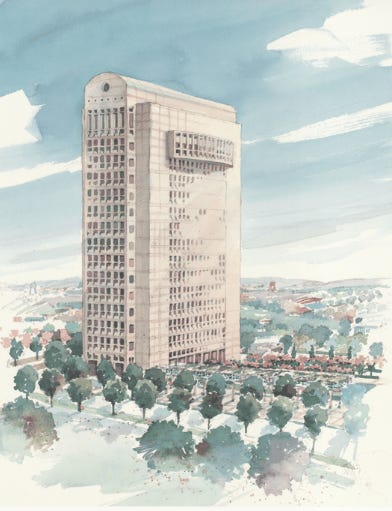

The building has the deep recessed windows of midcentury brutalism, but with too much ornamentation for proper béton brut. It has no apparent front or back side, makes no discernible visual nods to neighboring buildings, and draws the eyes upward to a mysterious curved penthouse of sorts. The architects want us to see it … a little differently.
“From the street level, the building displays a deft sleight-of-hand, becoming nearly transparent,” the prospectus tells us. (Having walked around the perimeter myself on a recent trip to Spartanburg, I can tell you the sleight-of-hand was lost on me; it looks and feels like a big concrete tower.)
The 18th floor, with its barrel-vaulted ceiling, was designed to hold a 200-seat corporate auditorium. On the 16th floor, cantilevered in curves, the architects placed open balconies with a view of the Blue Ridge Mountains — “a front porch in the sky,” as they described it.
At the time of construction from 1988-1990, Spartan Food Systems’ parent company TW Services — which also owned Denny’s — was fighting off a hostile takeover from a group of New York investors called Coniston Partners. This may have factored into TW’s decision, starting in 1990, to relocate the Denny’s headquarters from California, trim the executive suite, and consolidate its services in the Spartanburg tower.
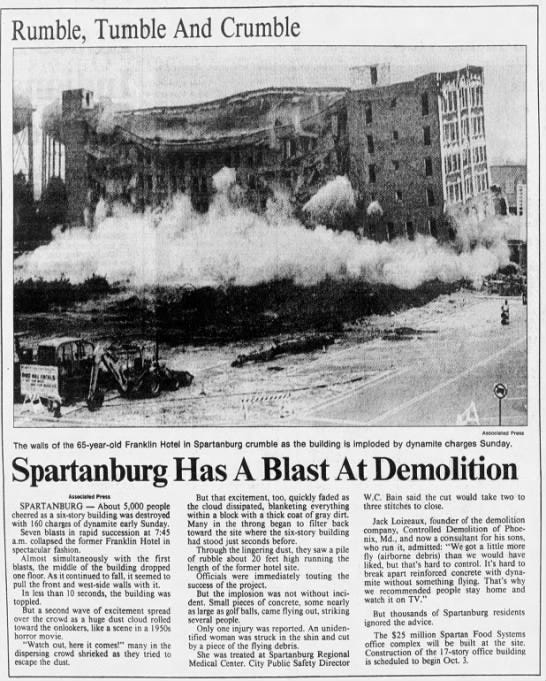
As Richardson and company looked to build a statement tower, city officials saw an opportunity to spark redevelopment of a depressed downtown district. The city had been trying to lure an Omni hotel to the Main Street corridor for years with no luck, and they saw the tower as a new anchor for development. City officials threw money at it in the form of a tax increment finance (TIF) district and even helped out by condemning properties that already existed on the site for demolition.
Among those buildings, the city condemned the neoclassical luxury Franklin Hotel, a 6-story historic landmark where Fred Astaire and Ginger Rogers once danced in the ballroom according to local lore. The owners of the hotel sued the city to challenge its condemnation of their property, eventually relenting when Spartan Food Systems offered to buy two tracts of land for a combined $975,000. News reports indicated the site could be used for a second tower one day; for now it contains a small public park with a playground.
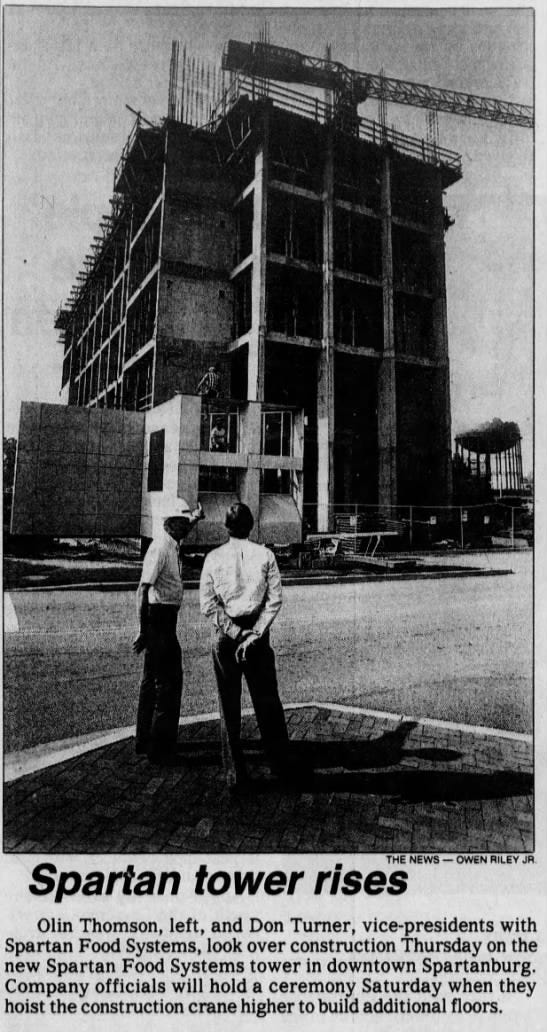
From a ledge
Cale Senterfitt hated heights, but the year was 2008 and window-washing was a recession-proof business. That’s how he found himself strapped into a harness system and stepping off a ledge on the Denny’s tower.
He had a uniquely dizzying experience with the “front porch in the sky.” In order to clean the narrow north and south ends of the tower, he rode an elevator to an upper floor, exited onto an open balcony, and strapped in for a long descent.
“There’s people out there having smokes and drinking coffee, and you just literally tie up to the concrete columns and climb over the side of the balcony. It’s nuts,” Senterfitt said.
On the broad east and west sides of the tower, Senterfitt recalls that the Denny’s building came equipped with a rolling track system for hooking up a swing stage scaffolding. By hanging a motorized platform from rollers attached to I-beams in the underside of the rounded balconies, a team of cleaners could theoretically start on the ground floor and ride in relative comfort all the way up, cleaning from side to side as they ascended.
The problem was, the company that had hired Senterfitt either couldn’t find or wouldn’t pay the money to rent swing stage scaffolding equipment in the South Carolina Upstate. So in order to clean the east and west faces of the tower, Senterfitt had to lean out of an upper-story window and hook himself into the track system. Even after triple-checking the harness, he struggled to overcome his most basic self-preservation instincts and step out into the air.
From the top, he rappelled straight down the side of the building with a bucket and cleaning equipment, then up the elevator again. He’d open another window, strap in again, and begin another descent. The process took days.
The Denny’s tower remains the tallest building Senterfitt ever cleaned. He remembers the upper floors were locked down with security-card access. As a result, he got to see parts of the building that few Spartanburg residents ever enter. He recalls walking through one advertising office and seeing two side-by-side display boards, one with the latest IHOP promotions and the other with Denny’s promotions.
Senterfitt worked on a team cleaning the Denny’s tower twice a year from around 2008 to sometime in the early 2010s before leaving to start his own company, Charles Towne Window Cleaning and Pressure Washing. He regrets underestimating the gutter system on the arched rooftop.
He had taken that part of the cleaning job assuming that the gutters at 18 stories up would be empty — no big deal, a quick inspection and then back inside through the roof hatch. What he didn’t anticipate was that storms had blown sand all the way to the top, pigeons had filled the gutters with guano, and fire ants had built colonies that swarmed him when he took a wrong step.
“One thing that I’m very aware of now that I wasn’t back then, new to the high rise industry, was that it doesn’t really matter how high up gutter systems are because nature finds a way, man,” Senterfitt said.
Looming
Ask a Spartan what they think of the Denny’s HQ building and you’re as likely to hear fascination, civic pride, or a local wisecrack (it’s formerly known as “Big Burger Tower,” from when the BB&T bank moved into the lobby and put its logo at the top of the tower).
Two years ago I spoke with a photographer who portrayed the tower with faux-religious awe. His name is Jack Martin, and he’s the proprietor of the Instagram account @dennyslooming. Living in Sparkle City for a few years in the late 2010s, he heard all the jokes and comparisons.
“Someone described it as a tombstone. Someone else described it as a toaster,” Martin said.
Driving into the city, and then walking around downtown with a local film photographers’ group, he realized one day that the tower felt omnipresent. While organizing his photos one day, he noticed he had inadvertently taken loads of pictures with the Denny’s headquarters lurking in the background.

On @dennyslooming, Martin imbued the tower with the character of “an all-powerful deity who is very nihilistic in nature,” Martin told me. A typical post from the now-mostly-dormant account included a moody film photo of the tower hulking over its environs, paired with an ominous caption.
“I am the void of endless possibility you see when you close your eyes. I am what you are all made of,” the tower announces in one post, peeking around some cityscape trees.
Martin, who has since relocated to Colorado, told me in 2021 that running the account changed his relationship to the tower. It’s an unavoidable landmark in a city he called home, an inland lighthouse of sorts. The office workers still light up their windows in the shape of a Christmas tree every December. The bright yellow sign still beams at the city like a smile.
“Now every time I see it, I can’t help but get a little chuckle,” he said.
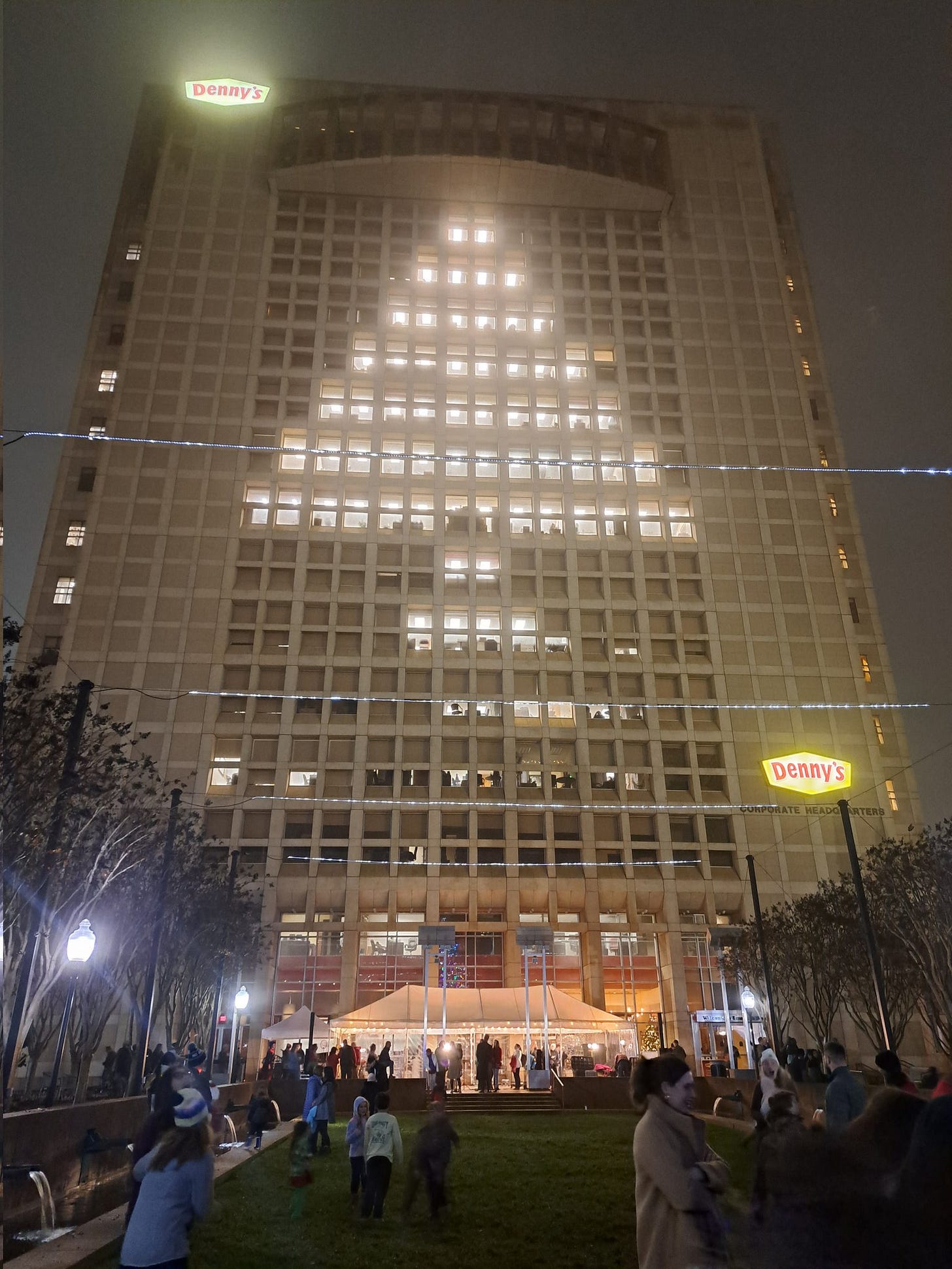
***
Jack Martin’s photography can be seen at ohjackmartin.com or on Instagram at @ohjackmartin.
Thank you to Spartanburg County Public Libraries for the archival scan of the Spartan Foods Plaza architectural prospectus. You can read the whole thing on DocumentCloud if you like.
If for some reason you need more Denny’s content in your life, check out this 2019 interview I did with a California kid who booked a punk show in a Denny’s. I also interviewed his mom, who said she was proud.
Brutal South is a free weekly newsletter about class struggle and education in the American South. If you would like to support my work and get access to the complete archive of subscriber-only stuff, paid subscriptions are $5 a month.
Bookshop // Twitter // Bandcamp // Spotify Podcasts // Apple Podcasts
Associated Press. “Spartanburg Has a Blast at Demolition.” The Charlotte Observer, Sept. 26, 1988, p. 2D.
Dighton, Dan. “Demolition readied in downtown for Spartan Food Systems site.” The Greenville News, Sept. 7, 1988, p. C1.
Keefe, Robert. "BB&T trying to make a name for itself in state." The Greenville News, Nov. 6, 1988, p. 4E.
Nutt, Karen. “Franklin Hotel hosted celebrities.” Spartanburg Herald-Journal, April 11, 2001.
Rizzuti, Anthony. “Jerry Richardson leaves behind a painfully ironic legacy.” USA Today, May 15, 2018.
Teter, Betsy. “Spartan Foods breaks ground.” The State, Oct. 4, 1988, p. 4C.

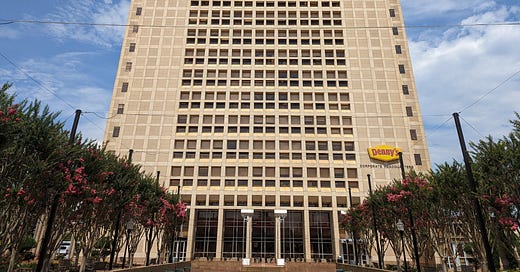


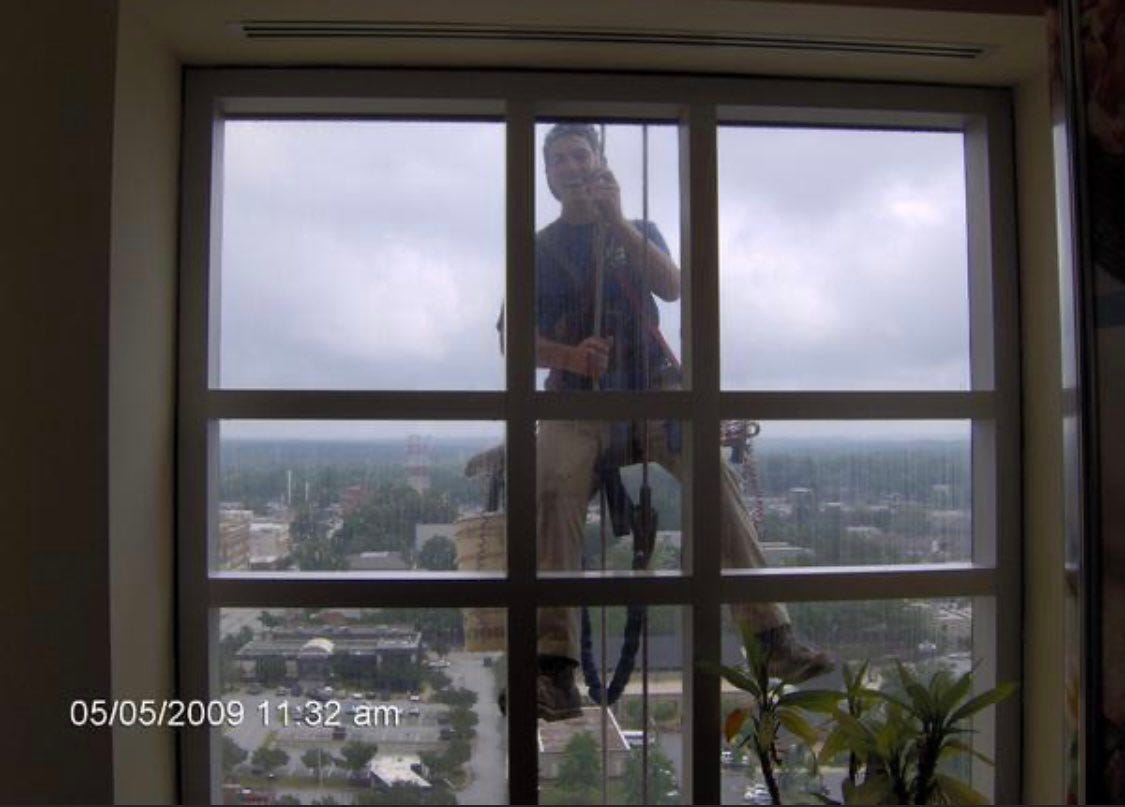
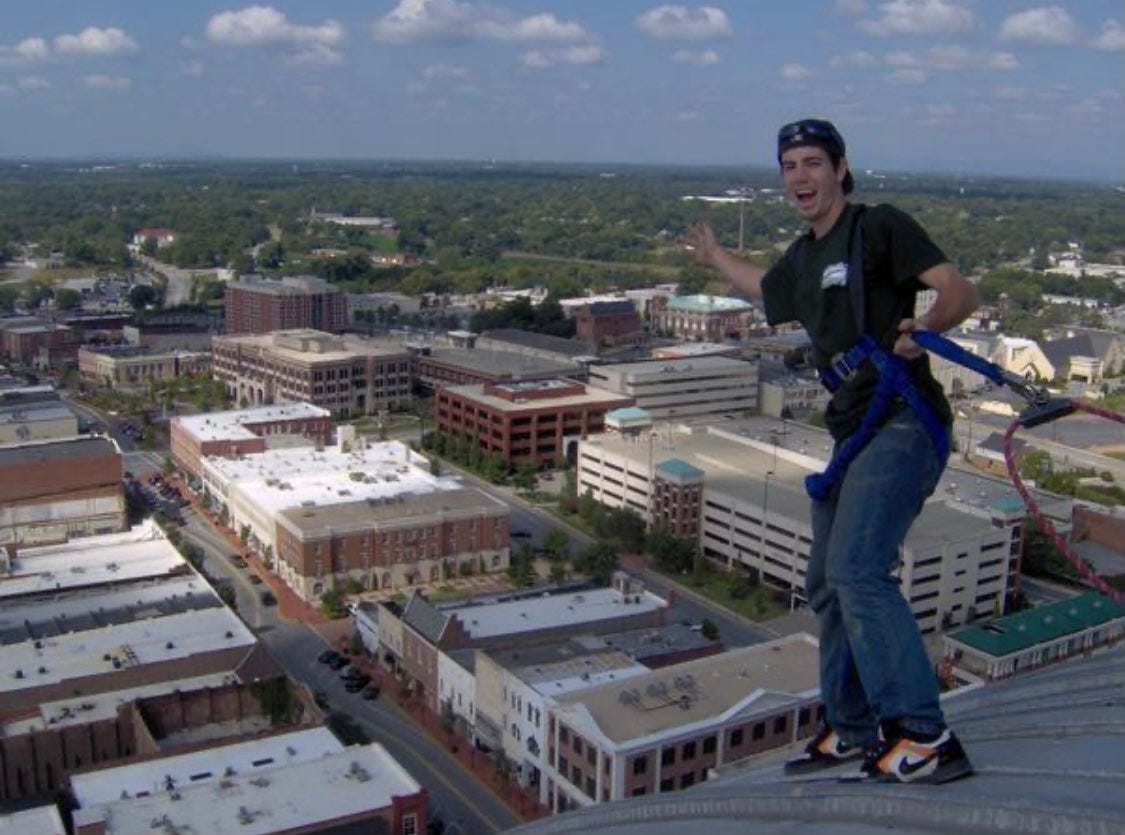
Always like your architectual writing. Solid reporting. You need to write that book
on Brutalism in the south.